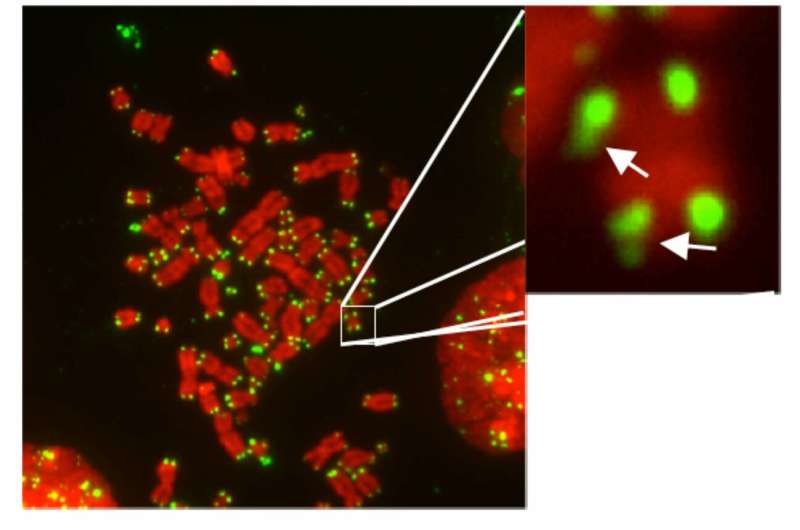Telomeres (in green) are at the tips of chromosomes (in red). Credit: Jose Escandell, IGC
The tips of chromosomes have structures called telomeres comparable to the plastic cover at the end of shoelaces. They work as a protective cap that prevents genetic material from unfolding and corroding. When telomeres do not work properly, the total erosion of genetic material can occur, triggering cancer and age-related diseases. In a study now published in the EMBO Journal, a research team from Instituto Gulbenkian de Ciência (IGC; Portugal), led by Jose Escandell and Miguel Godinho Ferreira, reports a key aspect of the regulation of telomeres.
Many human syndromes are attributed to telomere malfunction. One such disease was recently identified as the result of the malfunction of a protein complex known as CST, which is responsible for maintaining telomeres. Deficiencies in this complex give rise to a telomeropathy called Coats Plus. This syndrome is genetically inherited and characterized by abnormalities of the gastrointestinal system, bones, brain and other parts of the body. The IGC researchers now report details of the regulation of the "S" component of that CST complex. The researchers discovered that STN1 (the protein that corresponds to the S component) is regulated by a chemical modification that results in the insertion of phosphorus into this protein, and it can be reversed by an enzyme, the phosphatase SSU72. This process allows telomere duplication and regulation of telomerase, which is the enzyme that elongates telomeres.
The researchers also showed that this process is identical in yeast and in human cells. This means that the regulation of the "S" component has been conserved throughout evolution of species, which reveals the importance of this process for the correct functioning of cells.
The findings open new avenues to possible therapies for diseases associated with defects in telomeres. "The unanticipated role of this evolutionary conserved phosphatase is reminiscent of the regulation of the cell cycle by phosphatases that counteract the role of kinases, thus re-establishing the ground state of 'once and only once' cell cycle processes," says the investigator Miguel Godinho Ferreira. "With this work, we now understand better how telomere regulation works, a key process in cancer and aging," says Jose Escandell, first author of the publication.
More information: Jose Miguel Escandell et al. Ssu72 phosphatase is a conserved telomere replication terminator, The EMBO Journal (2019). DOI: 10.15252/embj.2018100476
Journal information: EMBO Journal
Provided by Instituto Gulbenkian de Ciência (IGC)





















